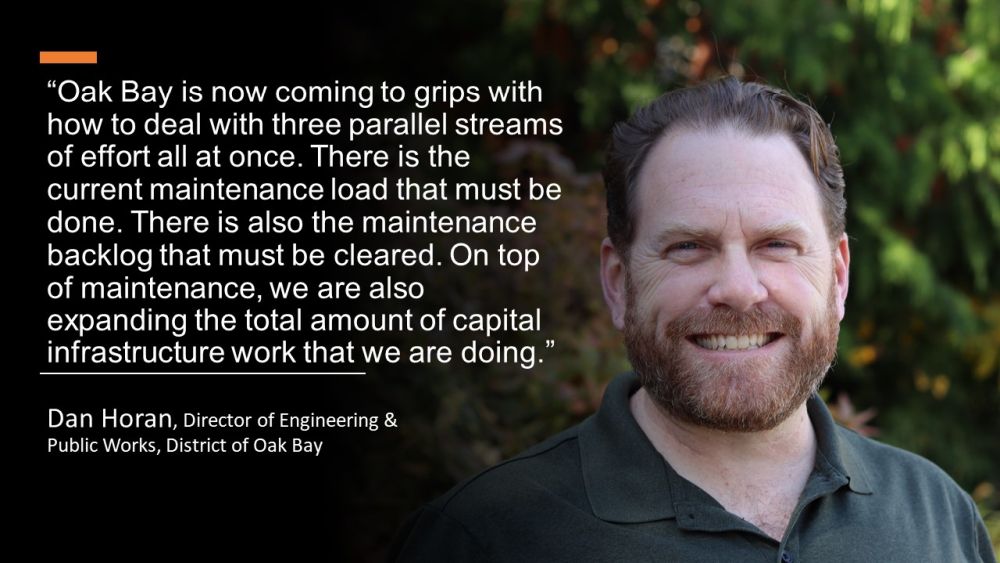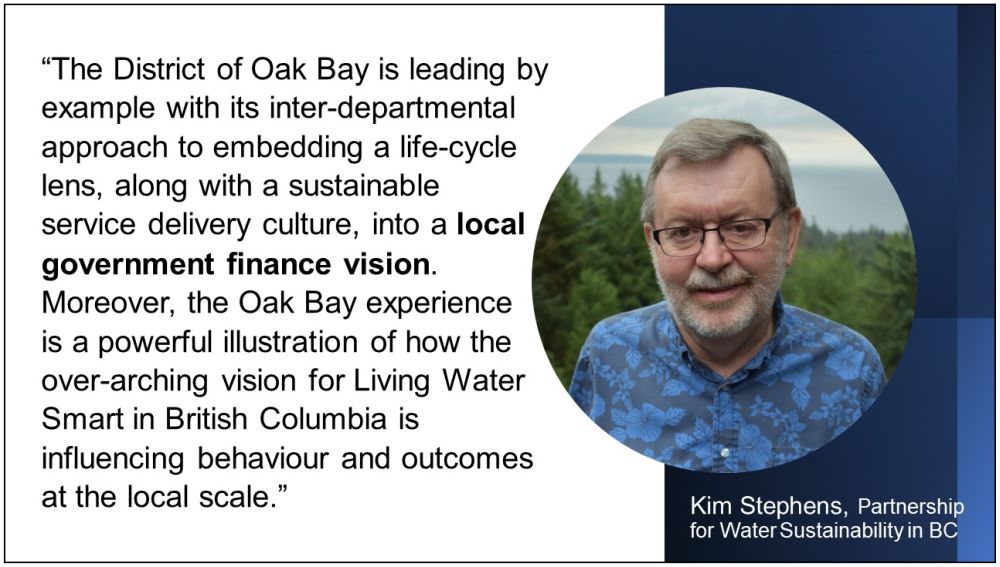LIVING WATER SMART IN BRITISH COLUMBIA: “Dealing with life-cycle realities is such a challenging area of engineering and utility asset management to think about. Many other fields of engineering have already been through multiple life cycles of the asset. They have already felt the pain of not doing it right,” stated Daniel Horan, Director of Engineering and Public Works, when he explained Oak Bay’s Sustainable Infrastructure Replacement Plan (January 2022)
NOTE TO READER:
Waterbucket eNews celebrates the leadership of individuals and organizations who are guided by the vision for Living Water Smart in British Columbia to build greener communities and adapt to a changing climate. The edition published on January 18, 2022 featured “the story behind the story” of the District of Oak Bay’s Sustainable Funding Plan for Infrastructure Replacement. Oak Bay has translated an intergenerational perspective into a life-cycle plan of action for perpetual infrastructure renewal.

Asset Management for Sustainable Service Delivery in the District of Oak Bay
“The Partnership for Water Sustainability believes that the Oak Bay infrastructure story is an important one for us to showcase and celebrate through our Living Water Smart in British Columbia Series. In a sentence, the Oak Bay story is a profile in courage,” stated Kim Stephens, Waterbucket eNews Editor and Executive Director.
“After reading and reflecting upon the consequential insights that Christopher Paine and Daniel Horan share in this story, our hope is that Councils and staffs with other local governments would recognize the opportunity to reach out and learn from the Oak Bay experience. The Oak Bay story is powerful for two interconnected reasons.”
Local Government Finance Vision
“First, it demonstrates what a local government can achieve when it chooses to be proactive. The Local Government Act is ‘enabling’ legislation such that: a) the provincial government provides local governments with policy and legal tools; and b) it is up to local governments whether they choose to use those tools.”
“The District of Oak Bay has chosen to tackle its infrastructure funding gap (liability), take an intergenerational perspective, and develop a local government finance vision. This demonstrates what the financial situation would be if the municipality increased funding, used debt, and caught up on replacing assets.”
“Secondly, the Oak Bay story illustrates how an idea seeded as a policy objective in Living Water Smart is playing out in practice as Asset Management for Sustainable Service Delivery in Oak Bay. Living Water Smart has 45 actions and targets, one of which states that: “Governments will develop new protocols for capital planning that will look at the life-cycle costs and benefits of buildings, goods and services.” This is the backdrop for the ‘story behind the Oak Bay story’.”

Policy Outcome: Create a Sustainable Service Delivery Culture
“The Living Water Smart policy objective is the genesis for Asset Management BC — co-chaired by the Ministry of Municipal Affairs and UBCM (Union of BC Municipalities) — which rolled out Asset Management for Sustainable Service Delivery: A BC Framework in 2015. Eligibility for senior government infrastructure grants is the incentive for local governments to embrace the BC Framework and thus fulfil the Living Water Smart policy objective. The BC Framework establishes expectations; it does not prescribe solutions. The Partnership is a champion supporter of the BC Framework.”
“Through a Memorandum of Understanding with Asset Management BC, the Partnership brings a whole-system perspective to the unfunded liability issue that is associated with drainage and creek systems. As UBCM’s Glen Brown stated at the Partnership’s 2015 Annual Water Sustainability Workshop, “The ultimate vision for Sustainability Service Delivery is that communities would manage natural assets in the same way that they manage their engineered assets”.”
“The 2015 workshop was the forum where Glen Brown introduced the Asset Management Continuum to illustrate steps in the Sustainable Service Delivery journey. Oak Bay is early in Step Two for core constructed infrastructure. As one of three municipal partners responsible for developing and implementing the Bowker Creek Blueprint and 100-Year Action Plan, Oak Bay is also involved in the Partnership’s program for mainstreaming EAP, the Ecological Accounting Process,” concluded Kim Stephens.

A Story of Interdepartmental Collaboration
“Incorporated in 1906, Oak Bay has aging municipal infrastructure that is visibly wearing out. This reality has serious implications for levels of service. It also poses affordability as well as community willingness to pay challenges for financing a long-term program of replacement and/or renewal,” stated Kim Stephens.
“Through its Sustainable Funding Plan, Oak Bay is demonstrating what a difference it makes when municipal staff have clear direction from Council to achieve two outcomes: 1) stem the incremental erosion of levels of service in the short-term; and 2) translate an intergenerational perspective into a life-cycle plan of action for perpetual infrastructure renewal.”
“In the January 18, 2022 edition of Waterbucket eNews, we featured the “story behind the Oak Bay story” as shared by Christopher Paine, Director of Financial Services, and Daniel Horan, Director of Engineering and Public Works. They bring a fresh approach, energy, and innovative thinking to the sustainable infrastructure mission. The story of their collaboration is inspirational. Their enthusiasm is contagious!”

Context for Oak Bay’s Sustainable Funding Plan for Infrastructure Replacement
“A significant portion of Oak Bay’s water, sanitary sewer, storm, and road assets are past their recommended useful life. Many other assets are well through their recommended useful life and are due for replacement imminently. Replacing these assets will come at a significant cost,” explained Daniel Horan, Director of Engineering and Public Works.
“Replacing these assets is considered critical if the District is aiming to sustain the current levels of service. Current funding levels are not sufficient to replace assets at the recommended pace. Council has expressed a desire to address this issue. Not addressing it will result in an increase in water main breaks, water quality challenges, sewer backups, and storm water issues with impacts to private property.”
“Tackling municipal infrastructure challenges requires teamwork, multiple skillsets, and a sustained effort over time to implement necessary changes. It is fun working with Chris Paine, Director of Financial Services. Our collaboration is a great example of a finance department and an infrastructure department working together.”
“We have real issues to tackle. But we also have the right tools in place. And we are making progress! Even if it is little baby steps at a time. It is very rewarding when you are progressing. The energy is there because problem-solving is exciting.”
TO LEARN MORE:
To read the complete story published on January 18th 2022, download a PDF copy of Living Water Smart in British Columbia: Asset Management for Sustainable Service Delivery in the District of Oak Bay.


